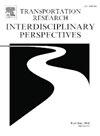基于时空图卷积神经网络的大规模城市交通信号预测
IF 3.8
Q2 TRANSPORTATION
Transportation Research Interdisciplinary Perspectives
Pub Date : 2025-07-01
DOI:10.1016/j.trip.2025.101482
引用次数: 0
摘要
本研究旨在通过深度学习方法解决大规模网络的交通信号问题。我们的最终目标是构建一个自动交通管理系统,由人工操作员发出命令,系统通过在十字路口执行适当的信号计划(SPs)或绿灯持续时间来实现这些命令。本文考虑了实现这一目标的第一步。本文基于图卷积神经网络,建立了两种处理时空图形数据的模型。所开发的模型既可以用于交通预测任务,也可以用于决策,例如在给定固定周期时间步长的十字路口绿灯时间。考虑了不同的数据集和特征。在第一个模型中,研究速度数据的预测,而在第二个模型中,预测绿灯次数和速度。考虑到特拉维夫的大规模城市网络,其中从位于网络信号交叉口的蓝牙传感器阵列中提取速度等数据特征,而其信号计划则代表交通运营商的命令。得到的结果表明:(i)在速度或绿灯时间预测任务中加入信号计划id和/或时间特征(月、年、日等)可以提高性能;(ii)与非周期时间步长相比,考虑固定周期时间步长可以增强预测能力;(iii)在绿色时间预测任务中加入蓝牙功能导致性能略有下降。本文章由计算机程序翻译,如有差异,请以英文原文为准。
Spatio-temporal Graph Convolutional Neural Network for traffic signal prediction in large-scale urban networks
This research aims at tackling the traffic signal problem for large-scale networks via a deep learning approach. Our ultimate goal is to construct an automatic traffic management system, where human operators supply commands, and the system realizes them via executing appropriate signal plans (SPs) or green durations in the intersections. The current paper considers the first step to achieve this goal. In this paper, two models that can handle spatio-temporal graphical data are developed based on Graph Convolutional Neural Network. The developed models can be utilized either for traffic prediction tasks or for decision-making, e.g. of green times in intersections, given fixed cycle time steps. Different dataset and features are considered. In the first model, prediction of speed data is examined, while in the second model green times and speed are predicted. The large-scale urban network of Tel Aviv is considered, where data features such as speed are extracted from an array of Bluetooth sensors located at the network signalized intersections, while its signal plans represent the traffic operators’ commands. The obtained results show that: (i) including signal plan IDs and/or temporal features (month, year, day, etc.) in speed or green time duration prediction tasks can improve the performance; (ii) considering fixed cycle time steps enhances the prediction compared with non-cycle-time steps; and (iii) including Bluetooth features in green times prediction task resulted with a slight degradation in performance.
求助全文
通过发布文献求助,成功后即可免费获取论文全文。
去求助
来源期刊

Transportation Research Interdisciplinary Perspectives
Engineering-Automotive Engineering
CiteScore
12.90
自引率
0.00%
发文量
185
审稿时长
22 weeks
 求助内容:
求助内容: 应助结果提醒方式:
应助结果提醒方式:


